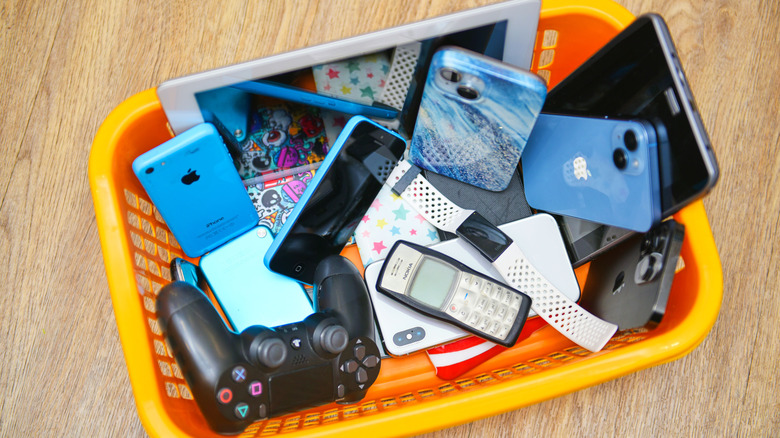Which US States Made It Illegal To Throw Away Electronics And Why?
Every year, a major flagship phone drops, and every year, many consumers discard their used devices to upgrade to the latest model. Sure, some of these outdated gadgets get handed down to family and friends, while other owners repurpose old home tech as alarm clocks or media centers. But for those electronics that have reached the end of their lifespan, they usually just end up in the trash.
This, however, isn't exactly the best way to dispose of electronic waste for various reasons. For one, e-waste contains heavy metals and other hazardous substances. If these get in contact with soil and water or are incinerated and ultimately fill the air, they can have a negative effect on our health and the environment. Devices with Li-ion batteries can be a fire hazard if dumped improperly as well.
When you throw away old electronics, you also waste the components (e.g., gold, copper) that can still be extracted for reuse in new devices. This then requires raw materials to be processed, putting more toll on the already limited natural resources. Then, of course, there's also the issue of the dumped devices adding to the ever-growing e-waste volume that needs to be managed. In fact, according to the UN Institute for Training and Research in 2022, the US is the second-biggest generator of e-waste in the world after China, producing almost 16 billion pounds.
For these reasons, 28 US states, including California, New York, and Texas, have passed e-waste laws that made it illegal for consumers to throw away their old and damaged electronics in the trash.
US States and their e-waste management programs
E-waste is more important than you realize and poses significant problems for both humans and the environment. To help in managing it, of the 50 US states, more than half (plus the District of Columbia) require consumers by law to recycle their electronics instead of simply throwing them in the bin. These states include:
- Northeast region: Connecticut, Maine, New Jersey, New York, Pennsylvania, Rhode Island, and Vermont
- Midwest region: Illinois, Indiana, Michigan, Minnesota, Missouri, and Wisconsin
- South region: Maryland, North Carolina, Oklahoma, South Carolina, Texas, Virginia, and West Virginia
- West region: California, Hawaii, Oregon, Washington, and Utah
Some states, although lacking an e-waste recycling law, have still made it illegal to discard certain electronics in incinerators and landfills. Among these states are New Hampshire, Massachusetts, and Colorado.
Not every e-waste law is the same, though — they don't exactly cover the exact same types of electronics. For instance, the Electronic Waste Recycling Act (EWRA) in California bans throwing away a wide range of devices with a display bigger than four inches. This includes CRT TVs and computer monitors, LCD and OLED laptops and desktop monitors, plasma TVs, portable DVD players with LCD screens, LCD smart displays and tablets, and cell phones. On the other hand, the Oregon E-Cycles program, which will take effect in January 2026, includes devices other than those with displays. The law bans consumers from improperly getting rid of electronics like game consoles, routers, modems, and digital converter boxes.
In Texas, the law only mentions the proper disposal for TVs and computers, including their bundled monitor, keyboard, and mouse. TVs, computers, laptops, and monitors are also illegal to be discarded in Washington state, but printers, keyboards, and mice aren't accepted at the E-Cycle locations.
How should you dispose of your electronics instead?
The right way to dispose of old electronics is different depending on the state, but many involve the manufacturers themselves. In New York, you can recycle your e-waste via one of two options. If you're buying new covered electronic equipment, you can return your old device of the same type (even if it isn't from the same brand) right at the store. Manufacturers also take back devices anytime for free. Just reach out to their acceptance program website or phone number listed on the NY Department of Environmental Conservation. There are e-waste collection sites around New York too. You can drop off your old devices here, but make sure to talk to them over the phone beforehand to make sure they take in the type of equipment you'll be bringing.
In Hawaii, every county (except for Kalawao) has at least one dedicated collection service offering drop-off sites, paid pickup, and collection events. You can opt to go with manufacturer-authorized collection services like ERI and OEM Recycling Solutions as well. However, expect to pay a fee starting from $100 per pickup. Mailing back your devices to certain manufacturers, including Apple, Google, and LG Electronics, is free, though.
On top of recycling locations and manufacturer programs, the Department of Energy and Environment in the District of Columbia itself hosts Household Hazardous Waste events a few times a year. Simply register for the event and show up on your assigned 15-minute schedule to drop off your devices.


